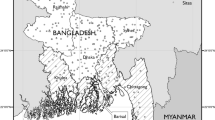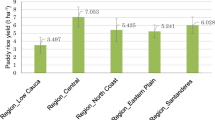Abstract
Narrowing the yield gap is a crucial way to increase grain production without increasing cultivated land to meet the growing demand for food and nutrients. Although estimation of yield gap in major grains (rice, wheat and maize) has been extensively studied at the field and experimental levels in recent decades, hardly any rigorous evidence-based studies have been performed at the farm level for the last decade in China. In this study, we employ production functions to estimate the yield gaps in rice farming and examine the different rice gaps in, e.g., regions and cultivation systems, using data collected from 1,029 farms in China in 2017. The results show that rice yield gap still existed in the surveyed region, although almost all farms had already achieved their potential yield (with a 2% yield gap). Age and distance between homesteads and plot have a negative effect on the yield gap, while household assets play an important role in narrowing the yield gap at the household level. Yield gap also varies considerably among regions, cultivated systems (i.e., early, one-season and late rice) and varieties. Policies aimed at ensuring grain self-sufficiency are suggested to focus more on technological changes to improve the potential yield rather relying on narrowing the yield gap at the household/farm level in rice production.
Similar content being viewed by others
Availability of data and material
Not applicable.
Code availability
Not applicable.
Notes
The value of the likelihood ratio test (1130.48) exceeded the critical value (χ2 (7) = 18.475) at the 1% level.
Given that surveyed farmers in Hubei and Jiangsu provinces only cultivated one-season rice, 949 observations of one-season rice farmers in three provinces were used in descriptive statistics and regression analyses.
References
Abdulai, A., & Tietje, H. (2007). Estimating technical efficiency under unobserved heterogeneity with stochastic frontier models: Application to northern German dairy farms. European Review of Agricultural Economics, 34(3), 393–416. https://doi.org/10.1093/erae/jbm023
Abedullah, Kouser, S., & Qaim, M. (2015). Bt Cotton, Pesticide Use and Environmental Efficiency in Pakistan. Journal of Agricultural Economics, 66(1), 66–86. https://doi.org/10.1111/1477-9552.12072
Affholder, F., Poeydebat, C., Corbeels, M., Scopel, E., & Tittonell, P. (2013). The yield gap of major food crops in family agriculture in the tropics: Assessment and analysis through field surveys and modelling. Field Crops Research, 143, 106–118. https://doi.org/10.1016/j.fcr.2012.10.021
Battese, G. E., & Coelli, T. J. (1995). A model for technical inefficiency effects in a stochastic frontier production function for panel data. Empirical Economics, 20(2), 325–332. https://doi.org/10.1007/BF01205442
Beddow, J. M., Hurley, T. M., Pardey, P. G., & Alston, J. M. (2014). Food Security: Yield Gap. In N. K. Van Alfen (Ed.), Encyclopedia of Agriculture and Food Systems, 352–365. Academic Press. https://doi.org/10.1016/B978-0-444-52512-3.00037-1
Beza , E., Silva, J. V., Kooistra, L., & Reidsma, P. (2017). Review of yield gap explaining factors and opportunities for alternative data collection approaches. European Journal of Agronomy, 82, 206–222. https://doi.org/10.1016/j.eja.2016.06.016
Campi, M., Dueñas, M., & Fagiolo, G. (2021). Specialization in food production affects global food security and food systems sustainability. World Development, 141, 105411. https://doi.org/10.1016/j.worlddev.2021.105411
Cassman, K. G. (1999). Ecological intensification of cereal production systems: Yield potential, soil quality, and precision agriculture. Proceedings of the National Academy of Sciences of the United States of America, 96(11), 5952–5959. https://doi.org/10.1073/pnas.96.11.5952
Coelli, T. J., Rao, D. S. P., O'Donnell, C. J., & Battese, G. E. (2005). An introduction to efficiency and productivity analysis. Springer Science & Business Media.
Cui, Z., Zhang, H., Chen, X., Zhang, C., Ma, W., Huang, C., et al. (2018). Pursuing sustainable productivity with millions of smallholder farmers. Nature, 555(7696), 363–366. https://doi.org/10.1038/nature25785
Deng, N., Grassini, P., Yang, H., Huang, J., Cassman, K. G., & Peng, S. (2019). Closing yield gaps for rice self-sufficiency in China. Nature Communications, 10(1), 1725. https://doi.org/10.1038/s41467-019-09447-9
Dzanku, F. M., Jirström, M., & Marstorp, H. (2015). Yield Gap-Based Poverty Gaps in Rural Sub-Saharan Africa. World Development, 67, 336–362. https://doi.org/10.1016/j.worlddev.2014.10.030
Evans, L. T. (1993). Crop Evolution, Adaptation and Yields.
Guan, Z., Oude Lansink, A., Van Ittersum, M., & Wossink, A. (2006). Integrating Agronomic Principles into Production Function Specification: A Dichotomy of Growth Inputs and Facilitating Inputs. American Journal of Agricultural Economics, 88(1), 203–214. https://doi.org/10.1111/j.1467-8276.2006.00848.x
Hoang, V. N. (2013). Analysis of productive performance of crop production systems: An integrated analytical framework. Agricultural Systems, 116, 16–24. https://doi.org/10.1016/j.agsy.2012.12.005
Huang, J. (2021). Recognition of Recent and Mid-long Term Food Security in China. Issues in Agricultural Economy, 1, 19–26. (in Chinese).
Huang, Y., & Tian, X. (2019). Food accessibility, diversity of agricultural production and dietary pattern in rural China. Food Policy, 84, 92–102. https://doi.org/10.1016/j.foodpol.2019.03.002
Jiangxi Bureau of Statistics. (2011–2019). Jiangxi Agriculture Yearbook. National Bureau of Statistics, Beijing.
Kumbhakar, S. C., & Lovell, C. K. (2003). Stochastic frontier analysis. Cambridge University Press.
Laborte, A. G., de Bie, K., Smaling, E. M. A., Moya, P. F., Boling, A. A., & Van Ittersum, M. K. (2012). Rice yields and yield gaps in Southeast Asia: Past trends and future outlook. European Journal of Agronomy, 36(1), 9–20. https://doi.org/10.1016/j.eja.2011.08.005
Lichtenberg, E., & Zilberman, D. (1986). The econometrics of damage control: why specification matters. American Journal of Agricultural Economics, 68(2), 261–273. https://doi.org/10.2307/1241427
Liu, B., Wu, L., Chen, X., & Meng, Q. (2016). Quantifying the Potential Yield and Yield Gap of Chinese Wheat Production. Agronomy Journal, 108(5), 1890–1896. https://doi.org/10.2134/agronj2016.03.0147
Liu, S., Pu, C., Ren, Y., Zhao, X., Zhao, X., Chen, F., et al. (2016). Yield variation of double-rice in response to climate change in Southern China. European Journal of Agronomy, 81, 161–168. https://doi.org/10.1016/j.eja.2016.09.014
Lobell, D. B., Cassman, K. G., & Field, C. B. (2009). Crop Yield Gaps: Their Importance, Magnitudes, and Causes. Annual Review of Environment and Resources, 34(1), 179–204. https://doi.org/10.1146/annurev.environ.041008.093740
Mueller, N. D., Gerber, J. S., Johnston, M., Ray, D. K., Ramankutty, N., & Foley, J. A. (2012). Closing yield gaps through nutrient and water management. Nature, 490(7419), 254–257. https://doi.org/10.1038/nature11420
Musser, W. N., & Patrick, G. F. (2002). How much does risk really matter to farmers? In R. E. Just & R. D. Pope (Eds.), A comprehensive assessment of the role of risk in US agriculture (pp. 537–556). Springer.
National Bureau of Statistics of China. (2018). China Statistical Yearbook. Bureau of Statistics, Beijing.
Neumann, K., Verburg, P. H., Stehfest, E., & Müller, C. (2010). The yield gap of global grain production: A spatial analysis. Agricultural Systems, 103(5), 316–326. https://doi.org/10.1016/j.agsy.2010.02.004
Nie, L., & Peng , S. (2017). Rice Production in China. Springer, Cham. https://doi.org/10.1007/978-3-319-47516-5_2
Peng, S., Tang, Q., & Zou, Y. (2009). Current Status and Challenges of Rice Production in China. Plant Production Science, 12(1), 3–8. https://doi.org/10.1626/pps.12.3
Qaim, M. (2020). Role of New Plant Breeding Technologies for Food Security and Sustainable Agricultural Development. Applied Economic Perspectives and Policy, 42(2), 129–150. https://doi.org/10.1002/aepp.13044
Rabbinge, R. (1993). The ecological background of food production. In D. J. Chadwick, J. Marsh (Eds.), Crop protection and sustainable agriculture. Ciba Foundation Symposium 177 (pp. 2–29). John Wiley & Sons.
Ren, Y., Castro Campos, B., Peng, Y., & Glauben, T. (2021). Nutrition Transition with Accelerating Urbanization? Empirical Evidence from Rural China. Nutrients, 13(3). https://doi.org/10.3390/nu13030921
Shi, Q., Liu, J., Wang, Z., Tao, T., Chen, F., & Chu, Q. (2012). Change of Rice Yield Gaps and Influential Climatic Factors in Southern China. Acta Agronomica Sinica, 38(5), 896–903. (in Chinese).
Silva, J. V., Baudron, F., Reidsma, P., & Giller, K. E. (2019). Is labour a major determinant of yield gaps in sub-Saharan Africa? A study of cereal-based production systems in Southern Ethiopia. Agricultural Systems, 174, 39–51. https://doi.org/10.1016/j.agsy.2019.04.009
Snyder, K. A., Miththapala, S., Sommer, R., & Braslow, J. (2016). The yield gap: Closing the gap by widening the approach. Experimental Agriculture, 53, 1–15. https://doi.org/10.1017/S0014479716000508
Struik, P. C., Kuyper, T. W., Brussaard, L., & Leeuwis, C. (2014). Deconstructing and unpacking scientific controversies in intensification and sustainability: why the tensions in concepts and values? Current Opinion in Environmental Sustainability, 8, 80–88. https://doi.org/10.1016/j.cosust.2014.10.002
Sumberg, J. (2012). Mind the (yield) gap(s). Food Security, 4(4), 509–518. https://doi.org/10.1007/s12571-012-0213-0
Tan, S., Heerink, N., Kuyvenhoven, A., & Qu, F. (2010). Impact of land fragmentation on rice producers’ technical efficiency in South-East China. NJAS - Wageningen Journal of Life Sciences, 57(2), 117–123. https://doi.org/10.1016/j.njas.2010.02.001
Tian, W., & Wan, G. (2000). Technical Efficiency and Its Determinants in China’s Grain Production. Journal of Productivity Analysis, 13(2), 159–174. https://doi.org/10.1023/A:1007805015716
Tian, X., & Yu, X. (2019). Crop yield gap and yield convergence in African countries. Food Security, 11(6), 1305–1319. https://doi.org/10.1007/s12571-019-00972-5
Van de Ven, G. W. J., De Ridder, N., Van Keulen, H., & Van Ittersum, M. K. (2003). Concepts in production ecology for analysis and design of animal and plant—animal production systems. Agricultural Systems, 76(2), 507–525. https://doi.org/10.1016/S0308-521X(02)00110-5
van Dijk, M., Morley, T., Jongeneel, R., van Ittersum, M., Reidsma, P., & Ruben, R. (2017). Disentangling agronomic and economic yield gaps: An integrated framework and application. Agricultural Systems, 154, 90–99. https://doi.org/10.1016/j.agsy.2017.03.004
van Ittersum, M. K., Cassman, K. G., Grassini, P., Wolf, J., Tittonell, P., & Hochman, Z. (2013). Yield gap analysis with local to global relevance—A review. Field Crops Research, 143, 4–17. https://doi.org/10.1016/j.fcr.2012.09.009
van Ittersum, M. K., & Rabbinge, R. (1997). Concepts in production ecology for analysis and quantification of agricultural input-output combinations. Field Crops Research, 52(3), 197–208.
Xu, Z., Guan, Z., Jayne, T. S., & Black, R. (2009). Factors influencing the profitability of fertilizer use on maize in Zambia. Agricultural Economics, 40(4), 437–446. https://doi.org/10.1111/j.1574-0862.2009.00384.x
Zhang, T., Yang, X., Wang, H., Li, Y., & Ye, Q. (2014). Climatic and technological ceilings for Chinese rice stagnation based on yield gaps and yield trend pattern analysis. Global Change Biology, 20(4), 1289–1298. https://doi.org/10.1111/gcb.12428
Zhang, X., Wang, D., Fang, F., Zhen, Y., & Liao, X. (2005). Food Safety and Rice Production in China. Research of Agricultural Modernization, 26, 85–88.
Zheng, H., Ma, W., Wang, F., & Li, G. (2021). Does internet use improve technical efficiency of banana production in China? Evidence from a selectivity-corrected analysis. Food Policy, 102, 102044. https://doi.org/10.1016/j.foodpol.2021.102044
Zhou, W., Wang, H., Hu, X., & Duan, F. (2021). Spatial variation of technical efficiency of cereal production in China at the farm level. Journal of Integrative Agriculture, 20(2), 470–481. https://doi.org/10.1016/S2095-3119(20)63579-1
Funding
This work was supported by the National Natural Science Foundation of China (grant numbers 71661147002) and the Ministry of Science and Technology of China (grant number 2016YFD0201301).
Author information
Authors and Affiliations
Contributions
All authors contributed to the study conception and design. Material preparation, data collection and analysis were performed by Zhiqi Sun, Yu Hong and Ruifa Hu. The first draft of the manuscript was written by Zhiqi Sun and Yu Hong, and all authors commented on previous versions of the manuscript. All authors read and approved the final manuscript.
Corresponding author
Ethics declarations
Conflicts of interest
The authors declare that they have no known competing financial interests or personal relationships that could have appeared to influence the work reported in this paper.
Rights and permissions
About this article
Cite this article
Sun, Z., Hu, R. & Hong, Y. Does yield gap still matter? Evidence from rice production in China. Food Sec. 14, 829–840 (2022). https://doi.org/10.1007/s12571-022-01261-4
Received:
Accepted:
Published:
Issue Date:
DOI: https://doi.org/10.1007/s12571-022-01261-4





